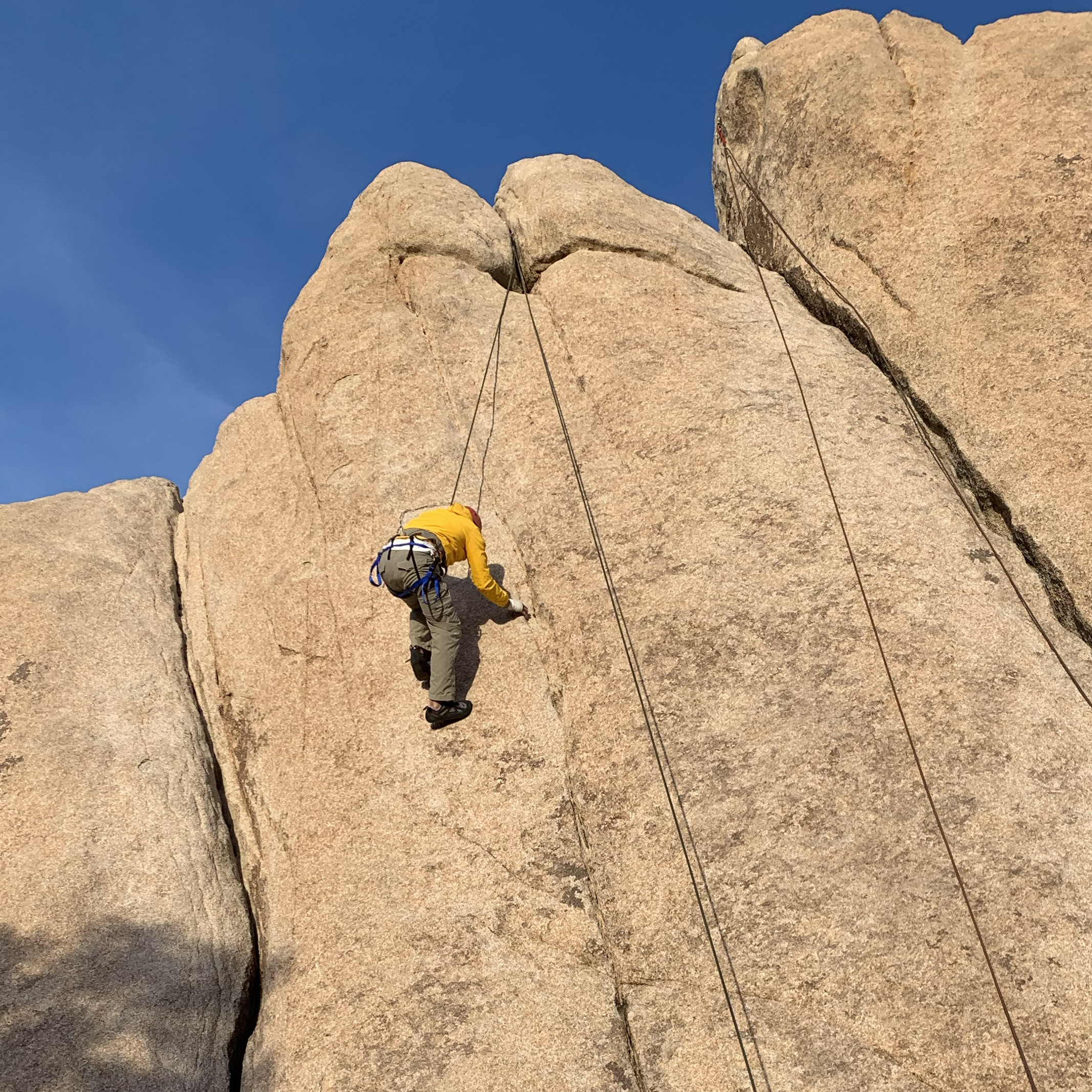05.26.2022
By uscbknpt
Climbing Back Up That Hill

How physical therapy is helping patients post-prostatectomy resume the life they want
BY DANIEL P. SMITH
THOUGH SEPARATED BY MORE THAN TWO DECADES in age and each sitting on the other side of 50, Geoff Howard and Al Moreno served as quintessential examples of robust, healthy American males.
In his early 50s, Howard embraced an active, healthy lifestyle. He ran daily during the week and devoted weekends to riding dirt bikes and playing tennis with his family. He monitored his diet and prioritized his physical health, eager to keep pace with his two active teenage children.
Meanwhile, Moreno defied logic. A former U.S. Marine and self-described “fitness freak,” Moreno bench pressed 270 pounds and completed America Ninja Warrior-styled workouts into his 70s. The Long Beach resident cut a chiseled frame with defined muscles leaping off his lean physique.
Over recent years, however, both encountered the shock of a prostate cancer diagnosis that threatened to upend their vigorous lives.
Taking on prostate cancer
Outside of skin cancer, prostate cancer is the most common cancer afflicting American males. About one in eight men will battle prostate cancer during their lifetime and the American Cancer Society (ACS) projects nearly 270,000 new cases in 2022 alone.
Fortunately, prostate cancer’s fatality rates fall well below its cancerous peers despite the condition’s prevalence. In fact, more than 3.1 million men who have been diagnosed with prostate cancer remain alive today, the ACS reports.
For many prostate cancer survivors, a prostatectomy — a surgical procedure in which part, if not all, of the prostate is removed — expunged the cancer and enabled men to add years, even decades, to their lives. Like any surgery, though, a prostatectomy carries risks, most notably urinary incontinence and erectile dysfunction.
While the surgeon’s role is to preserve life, the physical therapist’s role is to restore quality of life and function. After this surgery, physical therapy can help men recover faster, reduce leakage and help them get back to the life they want.
While the prostatectomy might succeed in eradicating the cancer, quality of life issues simmer below the surface and often trigger consternation.
Many men fret about incontinence and wearing adult diapers while the prospects of reduced physical strength or sexual function prove unsettling. Having their “manhood” under siege often breeds embarrassment, sparks mental health issues and stirs isolation.
Though it does not have to be that way, says Eileen Johnson, a USC Physical Therapy physical therapist who specializes in pelvic health.
“While the surgeon’s role is to preserve life, the physical therapist’s role is to restore quality of life and function,” says Johnson, who regularly works one-on-one with patients post-prostatectomy. “After this surgery, physical therapy can help men recovery faster, reduce leakage and help them get back to the life they want.”
The power of ‘prehab’
Before Howard endured his prostatectomy in February 2021 with Keck Hospital of USC’s Monish Aron, the Pasadena resident spent more than a year debating different treatment options. He carefully researched surgeons and weighed the surgery’s potential risks, including a consultation with Johnson to discuss the surgery’s potential impact on his body and lifestyle.
Once Howard digested all the available information and decided on a prostatectomy, he visited Johnson for the first of six one-on-one physical therapy sessions. Over six months, Johnson ran Howard through exercises focused on strengthening his hips, core and pelvic floor — movements designed to prepare the body for surgery and expedite his post-surgical recovery.

“This allowed Geoff to create the muscle memory necessary, so he could more readily isolate the pelvic floor due to his prior awareness training,” Johnson says.
A diligent patient who followed Johnson’s “prehab” orders, Howard emerged from surgery prepared to tackle recovery, including a post-surgical PT visit with Johnson one week after his procedure. Though Howard had purchased multiple packages of incontinence briefs fully expecting to have leakage issues, the urinary accidents never came.
“My body was ready for this,” says Howard, adding that his fears of reduced sexual function never materialized, either.
Within six months of surgery, Howard returned to his previous levels of running and tennis as well as riding motorcross weekly with his son, a particularly ambitious activity given the nature of the prostatectomy, which includes incisions near the midsection.
“I’m actually in better shape now than I was before the surgery, and I credit PT for much of that,” says Howard, who continues completing Johnson’s prescribed hip and core exercises on a routine basis more than a year after his prostatectomy.
Physical therapy propels post-surgical improvement
Unlike Howard, Moreno never had a prehab opportunity. Two days after a biopsy showed his prostate cancer, Moreno entered the operating room for his prostatectomy.
While the 2019 surgery removed the cancer, Moreno’s recovery proved frustrating. He struggled with lymphedema (swelling in his legs) as well as stress urinary incontinence that forced him to use up to a dozen pads each day. The muscle definition on his toned body softened and his physical strength waned.
During a follow-up appointment, Moreno’s Keck-based urologist, Hooman Djaladat, suggested physical therapy.
“I was up for it, too,” Moreno says. “I wasn’t going to roll over.”
Moreno began seeing Johnson twice a week, attacking her prescribed regimen of pelvic strengthening exercises with a determined spirit. As Johnson closely monitored Moreno’s physical recovery, she also layered on additional exercises as his strength returned.
Though Moreno still encounters some incontinence issues, his leakage is minimal, and he has returned to working out six days a week, including rock climbing and weight training.
“Physical therapy kept everything in check for me,” the 77-year-old Moreno says. “It was critically important to my physical and mental well-being and supercharged my recovery.”
In the coming months, Moreno plans to revisit Vietnam and, over 14 days, retrace the steps of his Marine Division’s 1969 mission dubbed “Operation Oklahoma Hills.” The endeavor, which will include lugging a 50-pound backpack of supplies by foot in steamy conditions, aims to bring awareness to the hundreds of thousands of U.S. military personnel impacted by Agent Orange exposure during the Vietnam War.
“I’m not able to do something so meaningful without recovering the way I have, and I owe much of that to my work with Eileen,” Moreno says.
Bringing PT to more patients post-prostatectomy
While PT is not the first thing patients or even other medical professionals think of when the prostatectomy is the chosen intervention, Johnson says pelvic floor rehabilitation under a trained therapist’s eyes can drive patients’ physical recovery and enhance their quality of life.
Following a prostatectomy, Johnson says the pelvic floor, hips and core often experience muscle atrophy. A thoughtful physical therapy treatment plan “will wake up, turn on and strengthen” those muscles to elevate bladder and bowel control, restore sexual functioning and empower patients to resume the regular activities they enjoy.
Both Howard and Moreno champion PT’s role in their respective recoveries from a prostatectomy, and Johnson hopes to improve awareness among the medical community and see many more patients avail themselves of PT services following the surgery.
To that end, Johnson is involved with USC’s Institute of Urology in a pre-op class for men detailing various aspects of the prostatectomy and highlighting PT’s potential to fuel recovery. Johnson also continues advocating for a standardized referral pattern that will direct patients to PT after a prostatectomy and, whenever possible, for prehab before surgery. In addition, she is pushing for increased pelvic health training among students and practicing physical therapists to increase capacity in this specialized area.
“Ultimately, we all want the same thing, which is patients comfortable and confident in their treatment plan and returning to a healthy life,” Johnson says.

